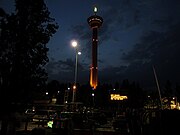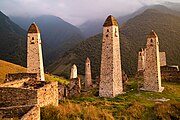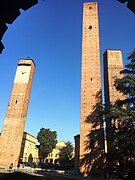Tower
This article needs additional citations for verification. (June 2023) |
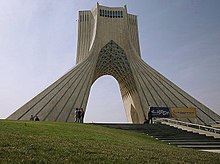
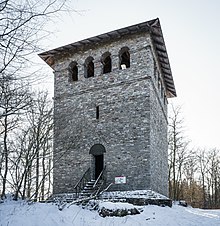
A tower is a tall
Towers are specifically distinguished from
Etymology
Old English torr is from Latin turris via Old French tor. The Latin term together with Greek τύρσις was loaned from a pre-Indo-European Mediterranean language, connected with the Illyrian toponym Βου-δοργίς. With the
History
Towers have been used by humankind since prehistoric times. The oldest known may be the circular stone tower in walls of
Some of the earliest surviving examples are the

Other well known towers include the
Mechanics
Up to a certain height, a tower can be made with the supporting structure with parallel sides. However, above a certain height, the compressive load of the material is exceeded, and the tower will fail. This can be avoided if the tower's support structure tapers up the building.
A second limit is that of buckling—the structure requires sufficient stiffness to avoid breaking under the loads it faces, especially those due to winds. Many very tall towers have their support structures at the periphery of the building, which greatly increases the overall stiffness.
A third limit is dynamic; a tower is subject to varying winds, vortex shedding, seismic disturbances etc. These are often dealt with through a combination of simple strength and stiffness, as well as in some cases tuned mass dampers to damp out movements. Varying or tapering the outer aspect of the tower with height avoids vibrations due to vortex shedding occurring along the entire building simultaneously.
Functions
Although not correctly defined as towers, many modern
Strategic advantages
The tower throughout history has provided its users with an advantage in surveying defensive positions and obtaining a better view of the surrounding areas, including battlefields. They were constructed on
Potential energy
By using gravity to move objects or substances downward, a tower can be used to store items or liquids like a
Communication enhancement
In history, simple towers like
Transportation support
Towers can also be used to support bridges, and can reach heights that rival some of the tallest buildings above-water. Their use is most prevalent in suspension bridges and cable-stayed bridges. The use of the pylon, a simple tower structure, has also helped to build railroad bridges, mass-transit systems, and harbors.
Other
- To access tall or high objects: tower crane
- To access atmospheric conditions aloft: tower telescope, solar powerstation
- To lift high tension cables for electrical power distribution transmission tower
- To take advantage of the temperature gradient inherent in a height differential: cooling tower
- To expel and disperse potentially harmful gases and particulates into the atmosphere: chimney
- To protect from exposure: lightning rod tower
- For industrial production: shot tower
- For surveying: Survey tower
- To drop objects: Drop tube (drop tower), bomb tower, diving platform
- To test height-intensive applications: elevator test tower
- To improve structural integrity: thyristor tower
- To mimic towers or provide height for training purposes: fire tower, parachute tower
- As art: Shukhov Tower
- For recreation: rock climbing tower
- As a symbol: The Tower (Tarot card), church tower
The term "tower" is also sometimes used to refer to firefighting equipment with an extremely tall ladder designed for use in firefighting/rescue operations involving high-rise buildings.
Gallery
-
The Galata Tower, also called Christea Turris (the Tower of Christ in Latin), was built in 1348 A.D. by the Genoese colony in Constantinople.
-
Typical modern water tower in Carmel, Indiana, United States
-
Watchtower in the Israeli West Bank barrier
-
The only bridge being a member of the World Federation of Great Towers: Most SNP, Bratislava, Slovakia
-
Medieval military towers from Ingushetia, Caucasus Mountains
-
Lifeguard tower, Asprovalta (Greece)
-
The towers of wind turbines support the rotors.
-
White Tower (Brixen)-Italy built in 1591
-
Some of the Towers of Pavia, 11th-13th century
-
The Aulanko Tower at the Aulanko Nature Reserve in Hämeenlinna, Finland
-
Rassef Islamic tower, Almussafes
See also
General
- Additionally guyed tower
- Bell tower
- Inclined towers
- Observation tower
- Partially guyed tower
- Smog tower
- World's tallest structures
- Spire
- Tower house
- Twin towers (architecture)
- List of tallest towers in the world
Warfare
- Battery tower
- Bergfried
- Breaching tower
- Butter-churn tower
- Flanking tower
- Fortified tower
- Gate tower
- Turret
- Watchtower
- Wall tower
References
- ^ Map, The Megalithic Portal and Megalith. "Diocletian's Palace". The Megalithic Portal.
- ^ Dana Thomas, "Towers to the Heavens", Newsweek, 2003-11-15
Further reading
- Fritz Leonhardt (1989), Towers: a historical survey, Butterworth Architecture, 343 pages.



